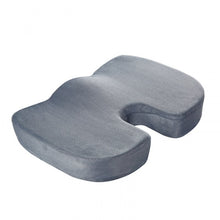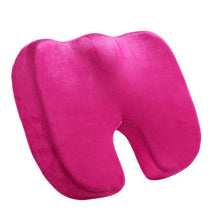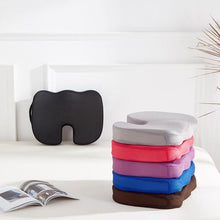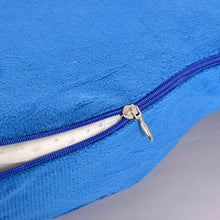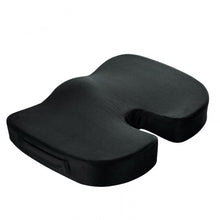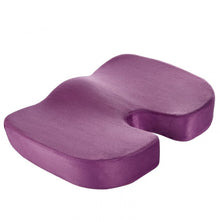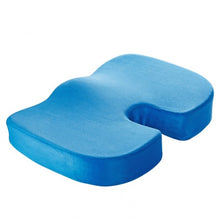
Coccyx Cushion for Tailbone Pain
Tailbone pain, also known as coccydynia or coccygodynia, affects the tailbone, also known as the coccyx. The coccyx is the small bone at the bottom of the spine and is made up of three to five fused vertebrae. Pain in this area can be caused by various factors, including injury, prolonged sitting, poor posture, and degenerative joint changes.
This coccyx cushion reduces pressure on your tailbone while you are sitting. It features a ''cut out'' that leaves the coccyx area open, which reduces direct pressure. Its memory foam construction redistributes weight more evenly across the hips and thighs, so it can also improve posture, provide comfort, and support healing. It can be used in the office, in the car, in a wheelchair, or while dining or flying.

The benefits – Cushion for tailbone pain
Using a therapeutic cushion for tailbone pain can significantly improve your comfort and healing. Benefits include:
✅ Reduces tailbone pressure: The cutout directs pressure on the coccyx while you're sitting, helping to relieve pain and prevent irritation.
✅ Improves posture: Its U-shaped design encourages better spinal alignment, which reduces strain on the lower back and tailbone.
✅ Provides comfort: Whether in the car, on a plane, or working at a desk, a cushion for your tailbone can make prolonged sitting much more bearable.
✅ Aids recovery: If you've injured your tailbone (from a fall or even childbirth), these cushions can support healing by keeping pressure off the area.
✅ Portable pain relief: Because the cushion can be used in various scenarios, you'll have consistent relief wherever you go.
✅ Damage prevention: Reducing pressure on your coccyx helps prevent chronic inflammation or long-term issues from repetitive stress.
✅ Improves circulation: They can help reduce compression of blood vessels in the pelvic area, especially if you sit for long hours.
✅ Help with related pain: They can also ease discomfort in your hips, legs or lower back by supporting proper weight distribution and reducing nerve compression in conditions like sciatica.
Product highlights – Tailbone cushion
- Orthopedically designed to reduce pressure on the coccyx or tailbone.
- The cutout removes pressure on the tailbone and can relieve pressure by redistributing weight away from the coccyx.
- High-quality memory foam ensures cushion strength and diffuses pressure, enabling users to sit comfortably for lengthy periods.
- It is lightweight and portable so that you can take it virtually anywhere.
- It is durable, and a breathable, removable cover will keep it clean and fresh, especially if you use it frequently.
- This medium-firm cushion strikes a good balance of comfort and support.
Product specifications – Tailbone sitting cushion
Colours: Black, grey, blue, purple, pink
Material: High-quality memory foam
Cover: Zippered, machine-washable cover
Dimensions: (L x W x H): 45cm x 35cm x 7cm

Who is a coccyx cushion ideal for?
Anyone experiencing discomfort from prolonged sitting, tailbone pain, or related conditions will benefit from a coccyx cushion, including:
-
People with tailbone pain: A coccyx cushion can significantly benefit individuals suffering from tailbone injuries (due to accidents, falls, or childbirth) or chronic coccydynia.
-
Office workers and those who do desk work: The constant pressure on your coccyx can lead to pain and discomfort if you spend long hours sitting at a desk. A coccyx cushion can help alleviate this, providing the support needed to prevent strain and improve posture while you work.
-
Pregnant women: Pressure on the pelvic region and tailbone can be uncomfortable during pregnancy, particularly in the later stages. A coccyx cushion reduces pressure, making long sitting periods more bearable.
-
Commuters and drivers: Whether you're driving to work, on a road trip, or commuting via public transport, sitting in a vehicle for extended periods can cause tailbone pain. A coccyx cushion offers comfort and support by relieving pressure on your tailbone.
-
Post-surgery recovery: After certain surgeries, such as pelvic or spinal surgery, a coccyx cushion can help reduce strain on the tailbone and promote recovery by ensuring comfort during sitting.
-
Elderly individuals: Older adults often experience issues with posture or pressure sores, especially when sitting for extended periods. A coccyx cushion can help improve comfort and reduce the risk of pressure ulcers.
Flexible use – Cushion for tailbone support
A coccyx cushion is incredibly versatile and can be used anywhere you sit, including:
-
At the office or desk: It will enhance comfort particularly if you sit for extended periods.
-
In your car: Will relieve pressure on your coccyx making for a more comfortable drive.
-
At home: You can use your cushion on any chair or seat around the house, whether at the dinner table, on a dining chair, or while watching TV on the lounge.
-
On outdoor chairs: Whether you're on your deck, at the park, or in a stadium, outdoor chairs can often lack support and comfort—coccyx cushions don't!
-
While travelling: If you're travelling by plane, train or bus, enhance your comfort with this portable cushion.
-
For rehabilitation or physical therapy: If you are recovering from surgery or an injury, a coccyx cushion can help you sit more comfortably during exercises or appointments.
-
If you are in a wheelchair: A coccyx cushion can improve posture, provide pressure relief, increase comfort, and help prevent skin damage from pressure ulcers.
User guide – Coccyx cushions for tailbone pain
Here's a simple user guide to help you get the most out of your coccyx cushion.
- Remove the cover and machine wash before use (follow the product's care instructions).
- Place the cushion on a flat seat—ensure the chair is firm and stable. The cutout should face the back of the chair so that your tailbone is directly over the open space. Make sure your buttocks are all the way back, with your lower back supported by the chair's backrest.
- Keep your feet flat on the floor, and your knees at a 90-degree angle. Keep your back straight, and your shoulders relaxed. Avoid slouching or leaning forward for long periods.
- It is designed for prolonged sitting, but it is recommended that you take a break every 30 minutes to an hour to stand, stretch, or walk to reduce stiffness and boost circulation.
- Clean the cushion regularly by removing the cover and machine washing. Dry and then store it in a dry place. Keep it away from heat or direct sunlight to avoid damaging the foam. The cushion can also be spot cleaned with a damp cloth. Do not soak or machine wash the foam itself.
- Replace the cushion if it loses its firmness or the foam doesn't bounce back.
FAQs | Coccyx Cushion
-
1. Can a coccyx cushion help with sciatic nerve pain?
Yes, a coccyx cushion can indirectly help with sciatic nerve pain. The sciatic nerve can be aggravated when your tailbone is under pressure, causing discomfort or pain radiating down the legs. By reducing pressure on the coccyx, tailbone cushions can help to align the spine properly, alleviate lower back pressure, and improve circulation. This can reduce the strain on the sciatic nerve, especially if you sit for long periods. Combine with exercises or stretches specifically targeting sciatica for enhanced relief.
-
2. How long can I sit on a coccyx cushion?
You can sit on a coccyx cushion for extended periods (one to two hours) without discomfort, but it's essential to take breaks. Prolonged sitting, even with a cushion, can lead to stiffness or worsen pain if you don't move around. It's recommended to stand or stretch every 30 to 60 minutes, even if you're using a cushion. When you're seated, ensure your posture is correct—feet flat on the ground, knees at a 90-degree angle, and your back is straight. Adjust your seating position to avoid pressure buildup, and take short walks or do stretches to improve circulation.
-
3. Can I use a coccyx cushion during pregnancy?
A coccyx cushion can benefit pregnant women experiencing tailbone pain, especially during the second and third trimesters. Pregnancy-related changes, such as weight gain and pressure on the pelvis, can increase the risk of coccyx pain. A tailbone cushion helps by alleviating pressure on the tailbone and encouraging better posture, which can reduce strain on the lower back and hips. It's also beneficial while driving or sitting for long periods at work.
-
4. How do I clean my coccyx cushion?
Cleaning a coccyx cushion is simple, but it's essential to follow the care instructions provided by the manufacturer. Ours has a removable cover, which can be machine-washed or spot-cleaned with a damp cloth. Avoid soaking or submerging the cushion, as this can damage the foam. Allow it to air dry completely to maintain its durability before using it again.
-
5. Who should not use a coccyx cushion?
Coccyx cushions aren't recommended for people with severe spinal conditions or injuries. Conditions like severe herniated discs, spinal stenosis, or spondylolisthesis may require specialised support beyond what a coccyx cushion offers. Consult your healthcare provider to ensure that the cushion won't exacerbate your condition. If you have open sores, skin infections, or wounds near your tailbone, using a cushion can cause irritation or slow the healing process. In this case, consider using a specialised medical cushion that promotes air circulation and avoids direct contact with the affected area. If you already have circulation issues or are prone to tingling or numbness in your legs, a coccyx cushion may make things worse. Extended periods of sitting, even on a cushion, can exacerbate circulation problems. People with morbid obesity or extreme weight issues might not get adequate support from a standard coccyx cushion. The cushion may compress too much under heavy weight, failing to relieve pressure.







